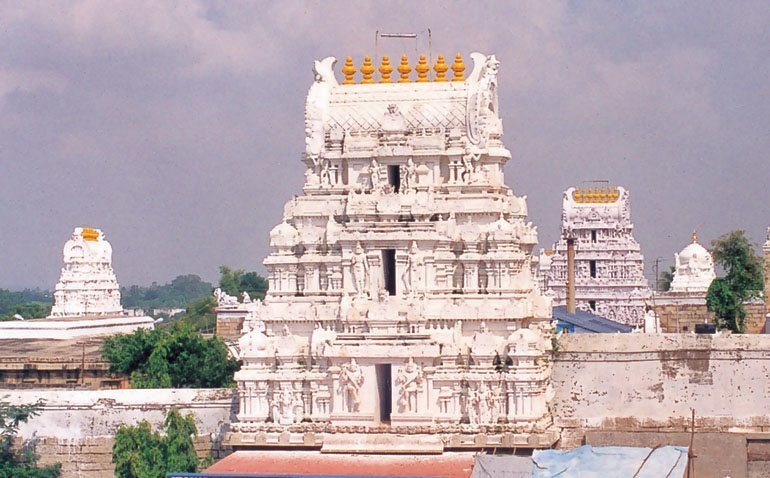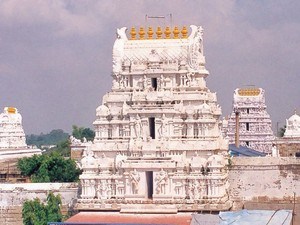Srikalahasteeswara Temple, Srikalahasti - Timings, Festivals, History, Darshan, Pooja Timings
 India | Andhra | Srikalahasti
India | Andhra | Srikalahasti
 #1 of 12 Places to Visit in Srikalahasti
#1 of 12 Places to Visit in Srikalahasti
 Distance (From Srikalahasthi Bus Station): 2 Kms
Distance (From Srikalahasthi Bus Station): 2 Kms
 Trip Duration (Including Travel): 1-2 Hours
Trip Duration (Including Travel): 1-2 Hours
 Transportation Options: Cab / Auto
Transportation Options: Cab / Auto
 Travel Tips: 1. Swarnamukhi River is located very close to this place and can be visited at the same time
Travel Tips: 1. Swarnamukhi River is located very close to this place and can be visited at the same time
2. Lord Vinayaka Temple is located very close to this place and can be visited at the same time
3. Varadaraja Swami Temple is located very close to this place and can be visited at the same time
At a distance of 2 km from Srikalahasti Bus Station, Srikalahasteeswara Temple (referred as Srikalahasti Temple) is one of the famous Shiva temples in South India. It is said to be the site where Kannappa, a great devotee of Shiva, was ready to offer both his eyes to cover blood flowing from the Siva linga before the Lord Siva stopped him and granted mukti.
The ancient Shiva temple of Sri Kalahasti finds reference in the three ancient epics the Skanda Purana, Shiva Purana and the Linga Purana. According to Skanda Purana, Arjuna came to this place to worship Kalahastheeswara (Lord Shiva) and met Rishi Bharadwaja on the peak of a hill.
This temple is one of the most impressive Siva temples in South India. This temple features 120 feet high enormous and ancient gopura over the main gate. The entire temple is carved out of the side of a huge stone hill. The initial structure of this temple was constructed by Pallava dynasty in the 5th century. Chola kings renovated the temple and constructed the main structure in 10th century. The outer walls and the 4 gopuras were built in the period of Sri Veera Narasimharaya of Vijayanagara Kingdom. The main gopura and the 100 pillars mandapa were constructed by Krishna Devaraya, the great Vijayanagara king in 1516.
Srikalahasti is regarded as one of the Pancha Bhoota Sthalas of Lord Shiva; the other four being Tiruvannamalai, Thiruvanaikaval, Chidambaram and Kanchipuram. This place represents Vayu, the Element of Air. This temple is also associated with Rahu and Ketu, two of the nine celestial bodies in the Indian astrological scheme. It is believed that a visit to this temple will provide relief to those who have the planet Rahu in inimical positions in their horoscopes.
There is a lamp inside the inner sanctum that is constantly flickering despite the lack of air movement inside. One can see the flames on several ghee lamps flicker as if blown by moving air. The linga is white and is considered Swayambhu (self-manifested). The temple is also known for great sculpture work all across the temple, most of which were built during Chola and Vijayanagar ruler.
The festival of Maha Shivaratri is celebrated with great zeal in February to March. Karthika Poornima is also celebrated grandly at this temple. The Raja Gopura of the temple has collapsed in 2010 and the efforts are on to rebuild the same.
After opening Sri Kalahasti Temple at early hours, Govu (Cow) will be taken inside temple and does circumambulate (pradakshinam) Lord Siva Temple and Sri Gnana Prasoonambika Temple prakaram. After Govu Pooja, devotees are allowed for Suprabhata Seva followed by Lord Siva and Gnana Prasoonambika Devi dashan.
Temple Timings: 6 AM to 9 PM.
Rahu Ketu Pooja Timings: 6:30 AM to 8:30 PM. Amavasya is the best day to perform Rahu Ketu Pooja.
Govu Pooja Timings: Saturday - Monday 4:30 AM and Tuesday - Friday 5 AM
Rs.300 - Rahu Ketu Pooja will be done in a huge hall outside the temple premises.
Rs.750 - Rahu Ketu Pooja will be done near the main temple premises in an A/C hall which has Shiva Sannidhi inside.
Rs.1500 - Rahu Ketu Pooja will be done inside the temple premises, which are also considered as VIP tickets.
Govu Puja cost: Rs. 50 per person.












